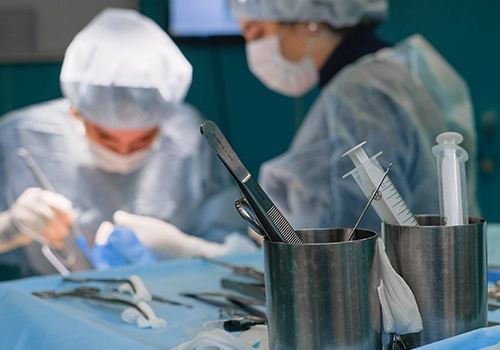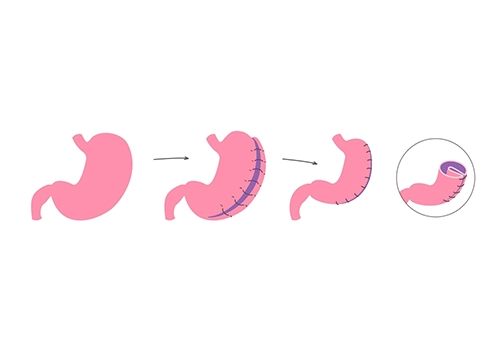Shaping a Healthier Future: The Surgical Gastric Plication for Weight Management
The WHO says obesity shortens life. Ten–15 years of life expectancy can be lost! It’s significant, right? Overweight people get sick and die young and may die mostly from diseases.
Surgery to treat obesity is one of the most efficient weight-loss methods. Understanding bariatric surgery’s benefits is key. This technique may boost metabolism and eliminate obesity-related diseases. Gastric plication is today’s topic. Weight loss with plication minimizes stomach size and food and calorie consumption.
Dr. Maadico’s Cosmetic Department in Iran offers Gastric Plication for a healthier, more vibrant life. Trust Dr. Maadico to help you thin down and get healthier with a comprehensive, all-encompassing strategy.
Who benefits from gastroplication?
- Individuals who are significantly obese and who have not been successful in losing weight through non-surgical approaches such as diet and exercise are the primary benefactors of Plication for obesity.
- People with a BMI of 35 or higher who have obesity-related health concerns, or those with a BMI of 40 or higher who do not have substantial comorbidities, are usually candidates for the operation.
It is critical to understand that weight loss surgery, including gastroplication, is not a cosmetic technique and is intended to address serious health issues connected with obesity. The following are some of the advantages of gastroplication:
- Weight loss
Because gastroplication reduces the size of the stomach, it can lead to a decrease in food consumption, allowing patients to lose weight.
- Obesity-related health conditions can be improved
Many obese people have conditions such as type 2 diabetes, hypertension, and sleep apnea. Weight loss as a result of gastroplication may improve or possibly resolve several comorbidities.
- Enhanced quality of life:
Successful weight loss can improve an individual’s general well-being and quality of life if they have struggled with obesity.
Diseases Targeted by Gastric Plication:
Obesity seems to increase serious health risks. Examples include:
- type 2 diabetes
- atherosclerosis
- angina
- hypertension
- heart attack
- stroke
Healthy living prevents these issues.

What is gastroplication?
Gastroplication is a medical procedure. Gastroplication is bariatric surgery. This therapy stitches the gastric wall along its greater curve to minimize stomach size. It’s fantastic because no stomach removal is needed. Today, we’ll cover a weight-loss and health-promoting technique. These treatments are usually for overweight or ill people. Health concerns may shorten their lives.
Gastric plication surgery
The surgeon carefully eliminates organ tissue during Stomach folding surgery. We carefully respect the stomach wall from the significant curvature. No organs are removed in gastric plication (sleeve 2). So, surgeons delicately sew a piece on the larger curve to restrict digestion.
Even with less food, a smaller stomach might make you feel full faster. We cut calories daily. Boluses of food travel readily through the digestive tract. The digestive system acts normally after gastroplication. So; our bodies absorb all wellness nutrients miraculously. It contains vitamins, microelements, and calming medicines.
After Laparoscopic gastric plication, People feel full faster and eat less. Picture a stomach pocket. Hospital doctors perform it under anesthesia.
Laparoscopic surgery is used for gastrointestinal treatments. They use these technologies to check and fix your stomach. Instead of large cuts, they make tiny front stomach holes. Endoscopic equipment helps. This method does not cut or scar the skin.
It usually takes 1–2 hours. Surgeons operate meticulously. They unite the stomach walls along the broad curve, using sutures to reduce it. Choosing to undergo Gastric plication surgery in Tehran offers a pragmatic option for individuals seeking weight loss. It presents an economical solution that can significantly improve the overall well-being and quality of life of patients.
Gastroplication Advantages and Disadvantages
We carefully maintain the organ during gastroplication. Digestion helps food travel through our stomachs. Knowing all necessary elements are absorbed is vital. The stomach’s volume returns after one year after surgery.
- The unique gastric plication operation can help overweight people. Up to 60% of excess weight can be removed efficiently.
- Treatment involves no organ removal but the stomach’s volume returns after one year after surgery.

- Remember that our bodies absorb vitamins, minerals, and medications. Problems after surgery are infrequent.
- Returning to full duty may take 1-2 weeks.
the operation’s medium- and long-term effects have been poorly studied. Clinical trials show this strategy has significant potential and will certainly work.
Gastric plication Risk
As with any surgical procedure, gastroplication carries certain risks and potential complications. It’s crucial for individuals considering this surgery to be aware of these risks and discuss them thoroughly with their healthcare provider. Some of the common risks associated with gastroplication include:
- Infection:
Infections can occur at the incision sites or within the abdominal cavity. Surgical procedures always carry a risk of infection, and steps are taken to minimize this risk through sterile techniques.
- Bleeding:
There is a risk of bleeding during or after surgery. Surgeons take precautions to control bleeding during the procedure, but in some cases, additional interventions may be necessary.
- Leakage:
Since gastroplication involves suturing or folding the stomach tissue, there is a potential risk of leakage at the suture lines. This can lead to serious complications and may require additional surgery to correct.
- Pneumonia or respiratory issues:
Individuals undergoing laparoscopic surgery may be at risk of developing pneumonia or other respiratory problems, particularly if they have pre-existing respiratory conditions.
- Adverse reactions to anesthesia:
Anesthesia is generally safe, but there is always a risk of adverse reactions. The anesthesiologist carefully monitors the patient during the procedure to minimize this risk.

- Gastrointestinal issues:
Changes in the anatomy of the stomach can sometimes lead to gastrointestinal issues such as nausea, vomiting, or difficulty swallowing.
- Unsatisfactory weight loss or weight regain:
While gastroplication is designed to induce weight loss, individual responses can vary. Some patients may not achieve the desired weight loss, and others may experience weight regain over time.
- Nutritional deficiencies:
Restrictive weight loss surgeries like gastroplication may limit the amount of nutrients absorbed by the body. Patients need to follow a strict postoperative diet and take nutritional supplements to prevent deficiencies.
It’s important for individuals considering gastroplication to have a thorough discussion with their healthcare team about the potential risks and benefits, as well as postoperative lifestyle changes necessary for a successful outcome. The decision to undergo any weight loss surgery should be made based on a careful evaluation of the individual’s overall health, lifestyle, and the severity of obesity.
Rehabilitation
Rehabilitation aids in injury and sickness recovery. The surgical hospital staff regularly watches patients.
- Drink only bubble-free water first. Take a little sip of your drink.
- Drink 5-10 ml every 10 minutes. We can only drink 500 cc each day.
- We need vitamins and minerals to keep healthy. Doctors may administer them intravenously.
- Eating liquids begins on day three.
- Healthier options! Reduced-fat broths and soups are good choices.
- Provide sugar-free tea and compote.
- Skim milk has less fat. These choices can keep us healthy!
- Slowly our daily intake will reach 1000 ml. A big number, huh? We shall drink 1000 ml daily. In case of nausea or vomiting, reduce it till you feel better.
- The patient will start taking soluble vitamins and minerals on day three.
- Start eating chopped boiled fish, meat, and poultry after a week. If you feel sick don’t eat it again and see a doctor.
- The patient can consume thicker foods after a month.
- Eat boiling fruits and veggies! Pick ones without rough peeling. Initial plans include vitamins and smaller meals.
- A modified regular diet can be introduced after two months.
- Avoid soda and gas-causing foods like fresh bread and wheat.
- Eat less and chew carefully.
- Consult a doctor or nurse if a new menu item makes you uncomfortable.

Patients should observe these rules
- Eating 5-6 small meals daily is essential.
- Food is limited to 100 ml.
- Avoid spices, pickles, and sour meals, which raise stomach acid.
- Monitor salt consumption.
- Be careful when eating or drinking hot or cold foods.
- After stomach plication, patients need hospital visits. These tests should occur every 6–12 months. Future exams will be crucial each year.
Your Next Step
Should you be contemplating the prospect of a Gastric Plication surgery, seize the opportunity for a complimentary consultation with our proficient experts at Dr. Maadico’s Cosmetic Department Situated in Iran. Our expert team stands ready to provide unparalleled services in the realm of Gastric Plication surgery. Your transformative path awaits, and our experts are here to guide you every step of the way.
If you’re ready for a change, request a free consultation.
You may also be interested in knowing about:
Sleeve Gastrectomy
Mini Gastric Bypass Procedure
Bariatric Gastric Bypass
Inflatable Gastric Balloon
Adjustable Gastric Band
FAQs
- How long does gastric plication last?
Gastric plication is considered a permanent weight loss solution. While the initial procedure typically takes 1-2 hours, the effects are intended to be long-lasting. However, the return to the stomach’s original volume might occur within the first year after surgery.
- What are the disadvantages of gastric plication?
Common disadvantages include the risk of infection, bleeding, leakage at suture lines, respiratory issues, adverse reactions to anesthesia, gastrointestinal problems, and the possibility of unsatisfactory weight loss or weight regain over time. Additionally, patients may need to adhere to a strict postoperative diet and take nutritional supplements to prevent deficiencies.
- What can you eat after gastric plication?
- Post-surgery, patients gradually progress from liquid to thicker foods.
- The initial days involve drinking small sips of liquids, including sugar-free tea, compote, and reduced-fat broths.
- After a week, patients may start with chopped boiled fish, meat, and poultry.
- Thicker foods can be introduced after a month, and a modified regular diet is possible after two months.
- Patients are advised to eat 5-6 small meals daily, limit food intake to 100 ml, and avoid certain foods that may cause discomfort.
- Is gastric plication permanent?
Gastric plication is considered a permanent procedure as it involves stitching the gastric wall to reduce stomach size.
- Is Gastric plication available in Iran?
Yes, Gastric plication is available in Iran. Choosing to undergo Gastric plication surgery in Dr. Maadico’s Cosmetic Department in Iran is presented as a pragmatic and economical option for individuals seeking weight loss.


